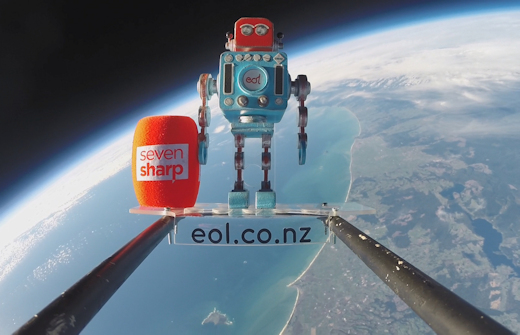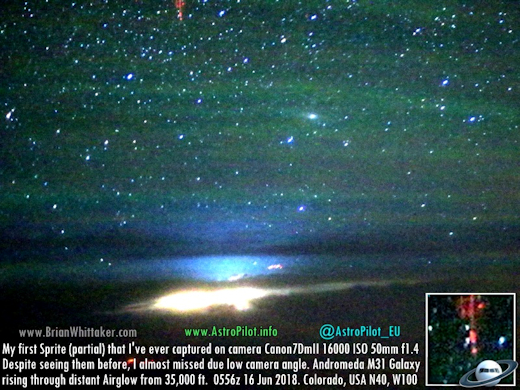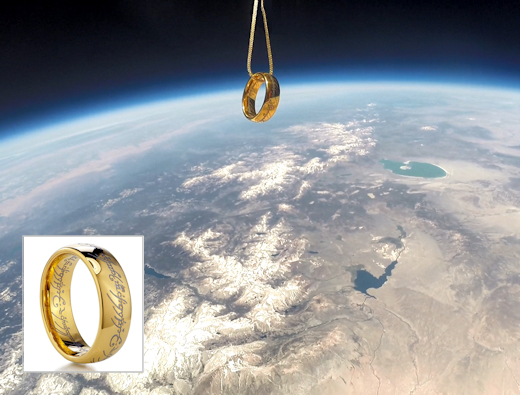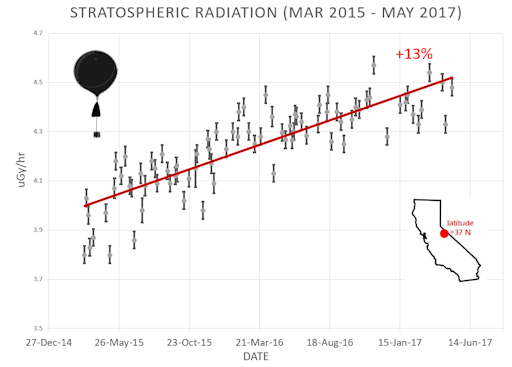All-inclusive Northern Lights trips in Tromsø, Norway. Small groups, big experiences! Highly qualified guides ensure unique and unforgettable adventures with a personal touch. Visit Explore the Arctic | | |
SLIGHT CHANCE OF FLARES: NOAA forecasters say there is a slight 5% chance of M-class solar flares today. The source would be big sunspot AR2715. Because AR2715 is almost directly facing Earth, any explosions would be geoeffective, possibly causing shortwave radio blackouts and minor geomagnetic storms. Free: Aurora Alerts.
SPACE WEATHER BALLOONS OVER NEW ZEALAND: On June 21st, the first day of winter in the southern hemisphere, Spaceweather.com and Earth to Sky Calculus launched two space weather balloons from New Zealand. It was a wonderful day as our California students worked closely with students from Mount Maunganui College and Otumoetai College to prepare the payloads and launch the balloons. In addition to our usual radiation sensors, the balloons carried experiments designed by local New Zealand students as well--one of them a robot programed to expose microbes to the environment of the stratosphere.

Only one bit of bad news marred the day: The second balloon we launched sailed into the Bay of Plenty and was lost along with a full complement of X-ray, gamma-ray, and neutron sensors.
On the bright side, the first balloon landed short of the beach and was recovered by a joint team of students from Earth to Sky and Otumoetai College. It was damp but intact--a complete success.
Flying balloons in a new country is always a learning experience. Telemetry from the lost payload given us important information about how to predict flight paths through the high atmosphere of Earth's 8th continent, and we will be launching another balloon tomorrow. Stay tuned!
A SPRITE SEEN FROM 35,000 FEET: Pilot Brian Whittaker has spent thousands of hours flying back and forth to London from the USA, and he has seen countless wonders of the night sky through the glass of the cockpit. This week for the first time, he photographed a sprite:

"I was very excited to finally photograph a sprite on the American Plains!" says Whittaker. "On June 16th, I was flying from Las Vegas to London when we flew by several very active thunderclouds. I had a prolonged view of countless rapid lightning flashes. This sprite leaped up from one of the thunderclouds."
The green bands in Whittaker's image are not auroras, but rather airglow. Airglow is caused by an assortment of chemical reactions in Earth's upper atmosphere. These reactions get started during daylight hours when the atmosphere is bathed in strong UV radiation from the sun. Sometimes, on dark nights, the green afterglow is visible, colored green by oxygen atoms 90-100 km high. Airglow occurs just above the altitude of most sprites.
"Sprites are really high up!" says Whittaker. "I wonder how many earlier sprites I've missed over the years because my camera was set just a little too low?"
Indeed. Summer is the season for sprites, and a good time for photographers to point their optics high, over the tops of towering thunderheads. Here's how.
Realtime Space Weather Photo Gallery
ONE RING TO RULE THE STRATOSPHERE: Today, the students of Earth to Sky Calculus are in New Zealand preparing to launch a trio of cosmic ray balloons over Earth's 8th continent. But first... on June 12th they launched a ring of power to the stratosphere. Here it is floating 33 km above the Sierra Nevada mountains of central California:

You can have one for $119.95. The students are selling these Tolkien-inspired rings as a fundraiser for their trip. They are made of golden-colored tungsten and inscribed with the authentic Mordor script of the One Ring.
Buy one now, and we will fly it again for you over Hobbiton, located in the North Island of New Zealand where our cosmic ray balloons will be released. Just note "Please fly it again!" in the comments section at checkout.
Each golden ring comes with a greeting card showing the ring in flight and telling the story of its journey to the edge of space. Sales support the Earth to Sky Calculus cosmic ray ballooning program and hands-on STEM research.
Far Out Gifts: Earth to Sky Store
All proceeds support hands-on STEM education
Realtime Aurora Photo Gallery
Realtime Noctilucent Cloud Photo Gallery
Every night, a network of
NASA all-sky cameras scans the skies above the United States for meteoritic fireballs. Automated software maintained by NASA's Meteoroid Environment Office calculates their orbits, velocity, penetration depth in Earth's atmosphere and many other characteristics. Daily results are presented here on Spaceweather.com.
On Jun. 22, 2018, the network reported 32 fireballs.
(32 sporadics)

In this diagram of the inner solar system, all of the fireball orbits intersect at a single point--Earth. The orbits are color-coded by velocity, from slow (red) to fast (blue). [Larger image] [movies]
Potentially Hazardous Asteroids (
PHAs) are space rocks larger than approximately 100m that can come closer to Earth than 0.05 AU. None of the known PHAs is on a collision course with our planet, although astronomers are finding
new ones all the time.
On June 22, 2018 there were 1912 potentially hazardous asteroids.
 |
Recent & Upcoming Earth-asteroid encounters: | Asteroid | Date(UT) | Miss Distance | Velocity (km/s) | Diameter (m) |
| 2018 LD4 | 2018-Jun-17 | 14.8 LD | 9.3 | 39 |
| 2018 KC3 | 2018-Jun-19 | 14.6 LD | 8.8 | 86 |
| 2018 MT6 | 2018-Jun-19 | 12.6 LD | 6.3 | 22 |
| 2018 LA6 | 2018-Jun-19 | 10.2 LD | 11 | 16 |
| 2018 MK | 2018-Jun-20 | 7.5 LD | 17.1 | 54 |
| 2018 MJ5 | 2018-Jun-21 | 11.7 LD | 8.2 | 16 |
| 2018 MA | 2018-Jun-21 | 19.3 LD | 16.6 | 48 |
| 2018 LX5 | 2018-Jun-21 | 5.2 LD | 11.7 | 32 |
| 2018 LS5 | 2018-Jun-21 | 6.5 LD | 9 | 17 |
| 2017 YE5 | 2018-Jun-21 | 15.6 LD | 15.5 | 513 |
| 467309 | 2018-Jun-23 | 17.9 LD | 14 | 355 |
| 441987 | 2018-Jun-24 | 7.3 LD | 12.6 | 178 |
| 2018 LD3 | 2018-Jun-24 | 19.8 LD | 14.2 | 69 |
| 2018 MX4 | 2018-Jun-27 | 5.5 LD | 8 | 15 |
| 2018 LN2 | 2018-Jun-28 | 10.5 LD | 9.4 | 88 |
| 2018 LR3 | 2018-Jun-29 | 6 LD | 3.8 | 20 |
| 2018 LT6 | 2018-Jul-01 | 11.6 LD | 13 | 126 |
| 2018 LJ1 | 2018-Jul-01 | 13.9 LD | 2.7 | 18 |
Notes: LD means "Lunar Distance." 1 LD = 384,401 km, the distance between Earth and the Moon. 1 LD also equals 0.00256 AU. MAG is the visual magnitude of the asteroid on the date of closest approach. | | Cosmic Rays in the Atmosphere |
Readers, thank you for your patience while we continue to develop this new section of Spaceweather.com. We've been working to streamline our data reduction, allowing us to post results from balloon flights much more rapidly, and we have developed a new data product, shown here:

This plot displays radiation measurements not only in the stratosphere, but also at aviation altitudes. Dose rates are expessed as multiples of sea level. For instance, we see that boarding a plane that flies at 25,000 feet exposes passengers to dose rates ~10x higher than sea level. At 40,000 feet, the multiplier is closer to 50x. These measurements are made by our usual cosmic ray payload as it passes through aviation altitudes en route to the stratosphere over California.
What is this all about? Approximately once a week, Spaceweather.com and the students of Earth to Sky Calculus fly space weather balloons to the stratosphere over California. These balloons are equipped with radiation sensors that detect cosmic rays, a surprisingly "down to Earth" form of space weather. Cosmic rays can seed clouds, trigger lightning, and penetrate commercial airplanes. Furthermore, there are studies ( #1, #2, #3, #4) linking cosmic rays with cardiac arrhythmias and sudden cardiac death in the general population. Our latest measurements show that cosmic rays are intensifying, with an increase of more than 13% since 2015:

Why are cosmic rays intensifying? The main reason is the sun. Solar storm clouds such as coronal mass ejections (CMEs) sweep aside cosmic rays when they pass by Earth. During Solar Maximum, CMEs are abundant and cosmic rays are held at bay. Now, however, the solar cycle is swinging toward Solar Minimum, allowing cosmic rays to return. Another reason could be the weakening of Earth's magnetic field, which helps protect us from deep-space radiation.
The radiation sensors onboard our helium balloons detect X-rays and gamma-rays in the energy range 10 keV to 20 MeV. These energies span the range of medical X-ray machines and airport security scanners.
The data points in the graph above correspond to the peak of the Reneger-Pfotzer maximum, which lies about 67,000 feet above central California. When cosmic rays crash into Earth's atmosphere, they produce a spray of secondary particles that is most intense at the entrance to the stratosphere. Physicists Eric Reneger and Georg Pfotzer discovered the maximum using balloons in the 1930s and it is what we are measuring today.
| | The official U.S. government space weather bureau |
| | The first place to look for information about sundogs, pillars, rainbows and related phenomena. |
| | Researchers call it a "Hubble for the sun." SDO is the most advanced solar observatory ever. |
| | 3D views of the sun from NASA's Solar and Terrestrial Relations Observatory |
| | Realtime and archival images of the Sun from SOHO. |
| | from the NOAA Space Environment Center |
| | fun to read, but should be taken with a grain of salt! Forecasts looking ahead more than a few days are often wrong. |
| | from the NOAA Space Environment Center |
| | the underlying science of space weather |
 | Reviews here can help you to pick up best memory foam mattresses. |
| | These links help Spaceweather.com stay online. Thank you to our supporters! |
| | | | | | |

